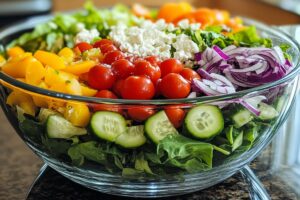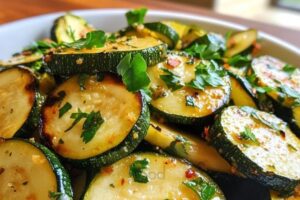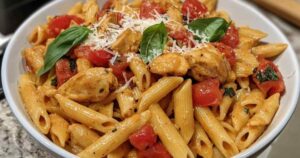Tomato zucchini pasta transforms simple garden vegetables into a satisfying weeknight dinner that’s ready in just 30 minutes. This light yet filling dish combines the sweetness of blistered cherry tomatoes with tender sautéed zucchini for a meal that feels both fresh and comforting.
There’s something magical about the way cherry tomatoes burst in a hot skillet, releasing their juices to create a naturally silky sauce. I discovered this combination during a particularly abundant summer when my neighbor’s garden was overflowing with zucchini and tomatoes—much like the vegetables you might find in a roasted veggie chickpea bowl. What started as a way to use up extra vegetables quickly became one of our family’s most requested dinners. The beauty of this tomato zucchini pasta lies in its simplicity—each ingredient shines without competing for attention, and the whole dish comes together faster than ordering takeout.
Let’s get cooking!
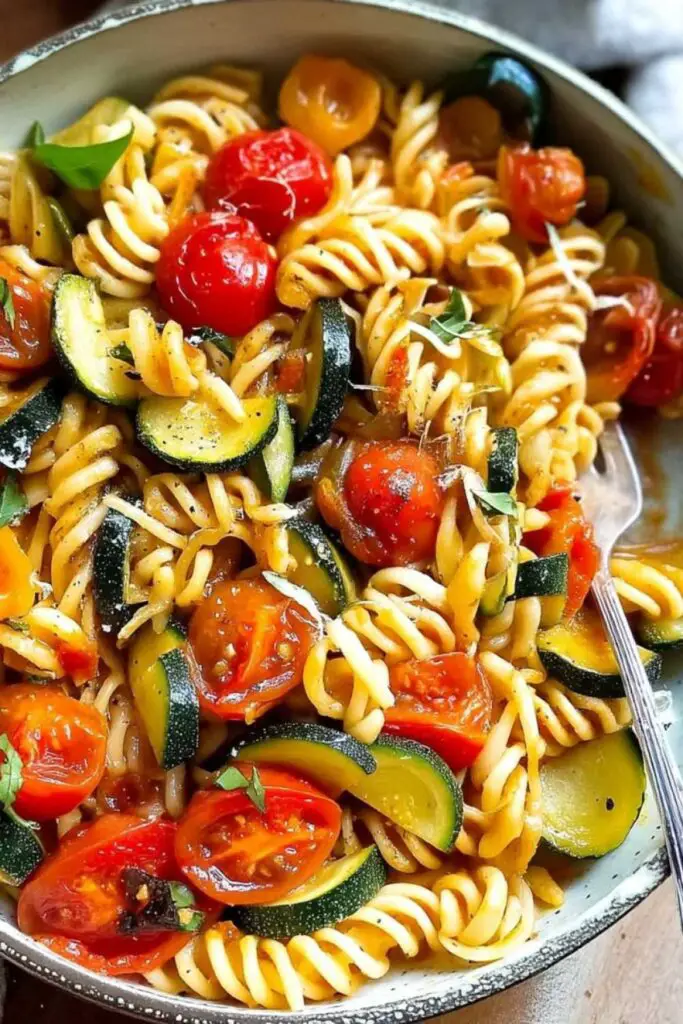
Why You’ll Love This Tomato Zucchini Pasta
This pasta dish has become a staple in my kitchen because it perfectly balances fresh flavors with practical weeknight cooking. I’ve served this tomato zucchini pasta to picky eaters and veggie skeptics alike, and it wins them over every single time.
- Quick weeknight dinner ready in 30-40 minutes with minimal prep work
- Budget-friendly meal using simple pantry staples and affordable vegetables, similar to our Mongolian noodles with ground beef that maximizes flavor without breaking the bank
- Veggie-packed dish that sneaks nutrition into every bite without tasting “healthy”
- Customizable heat level—add cayenne and chili flakes for spice lovers or skip them for kids
- Light but satisfying combination that won’t leave you feeling heavy after dinner
- Perfect way to use up garden vegetables or rescue wilting produce from your fridge
This colorful pasta is more than just dinner—it’s a celebration of simple, fresh ingredients that bring families together around the table.
Ingredient Note List
Fusilli Pasta: The spiral shape of fusilli catches all the delicious vegetables and cheese, making every bite perfectly balanced with flavor. If you enjoy learning about different pasta shapes and their uses, check out our guide on what is tortellini pasta.
Green Zucchini: I always choose firm, medium-sized zucchini because they hold their shape better when sautéed and won’t turn mushy in the pan.
Cherry Tomatoes: These little gems burst naturally during cooking to create a light, fresh sauce that coats the pasta beautifully without being heavy.
Olive Oil: Good quality olive oil forms the base of this dish and helps the vegetables caramelize while adding that essential Mediterranean flavor.
Garlic Powder: I use garlic powder instead of fresh garlic because it distributes more evenly and won’t burn during the quick sautéing process.
Fennel Seeds: These aromatic seeds add a subtle, sweet licorice note that complements the tomatoes and makes this tomato zucchini pasta taste restaurant-quality.
Vegetable Broth: A splash of broth helps the tomatoes release their juices and creates the perfect amount of moisture for the pasta sauce.
Parmesan Cheese: Freshly grated parmesan melts into the warm pasta and vegetables, creating a creamy coating that brings everything together.
Fresh Herbs: Basil or parsley adds a bright, fresh finish that makes the entire dish feel vibrant and garden-fresh.
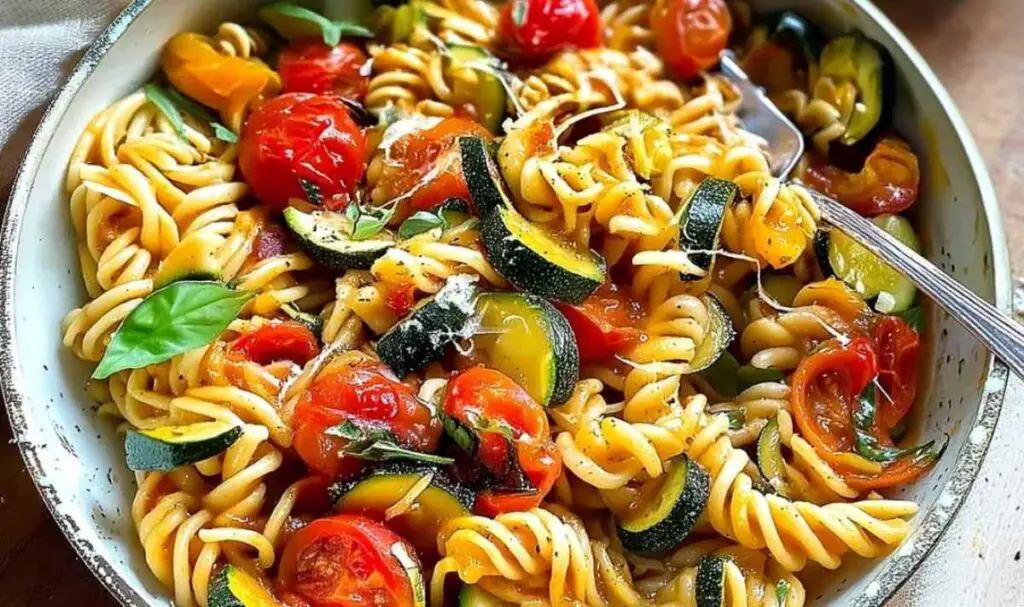
How to Cook Tomato Zucchini Pasta
Step 1. I always start by bringing a large pot of generously salted water to a rolling boil—the water should taste like the sea for perfectly seasoned pasta.
Step 2. Add the fusilli pasta to the boiling water and cook according to package directions until al dente, usually about 8-10 minutes, then drain thoroughly without rinsing.
Step 3. While the pasta cooks, I dice the zucchini into bite-sized pieces and heat olive oil in my largest skillet over medium heat to give everything room to cook evenly.
Step 4. Sauté the diced zucchini for 5-7 minutes, stirring occasionally, until the edges turn golden and the pieces are tender but still have a slight bite.
Step 5. My grandmother always said to cook vegetables in batches if needed, so transfer the zucchini to a plate and add the cherry tomatoes to the same hot skillet.
Step 6. Add the black pepper, fennel seeds, garlic powder, and optional cayenne to the tomatoes along with the vegetable broth, then cover and cook for 5-7 minutes until the tomatoes blister and soften.
Step 7. I’ve found that pushing the tomatoes to one side of the skillet makes room to add back the zucchini, pasta, and parmesan cheese without overcrowding.
Step 8. Stir everything together gently and reheat for 2-3 minutes, allowing the cheese to melt and coat the pasta—add a splash more broth if the mixture seems too thick.
Step 9. Serve immediately while hot, drizzled with extra olive oil and garnished with fresh herbs and additional parmesan cheese for the perfect finishing touch.
How to Store & Reheat
I usually store leftover tomato zucchini pasta in an airtight container in the refrigerator, where it stays fresh for up to 3 days. For another delicious pasta option that reheats well, try our shrimp stir fry with noodles. The vegetables may soften slightly, but the flavors actually develop and improve overnight.
For reheating, I recommend adding a splash of vegetable broth or water to a skillet and gently warming the pasta over medium heat for 2-3 minutes. This method revives the sauce better than the microwave and prevents the pasta from drying out.
While this dish is best enjoyed fresh, you can prepare the vegetables up to one day ahead and store them separately. I don’t recommend freezing this particular recipe since the zucchini and tomatoes don’t freeze well and become watery when thawed.
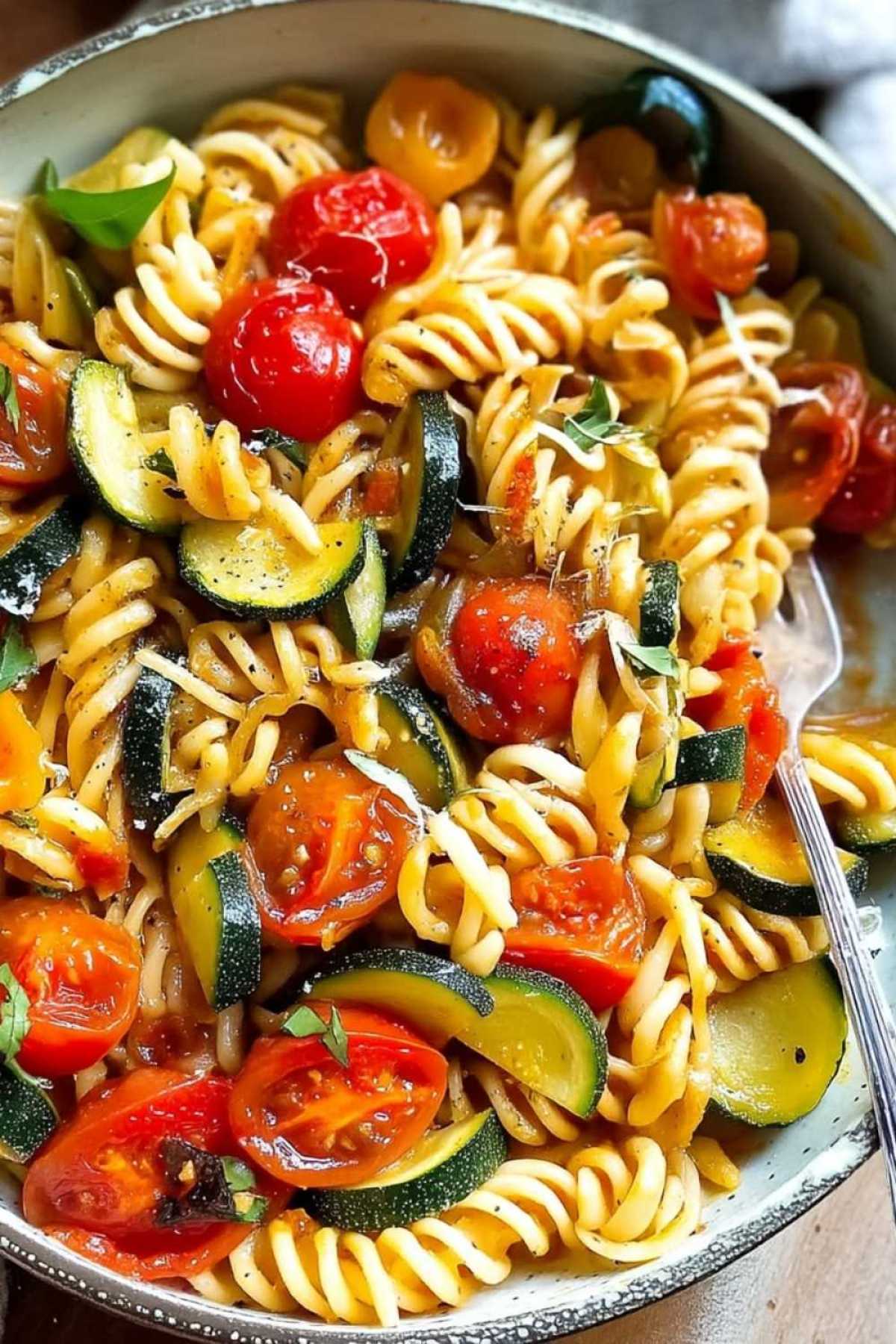
Tomato Zucchini Pasta
Ingredients
Equipment
Method
- Bring a large pot of well-salted water to a boil. Cook fusilli until al dente, 8–10 minutes. Reserve 1/2 cup pasta water, then drain.
- Heat 2 tbsp olive oil in a large skillet over medium heat. Add diced zucchini and cook 5–7 minutes, stirring occasionally, until golden on edges and tender. Transfer to a plate.
- In the same skillet, add cherry tomatoes, black pepper, fennel seed, garlic powder, cayenne (optional), and 1/4 cup vegetable broth. Cover and cook over medium heat, stirring occasionally, 5–7 minutes until tomatoes blister and soften but keep their shape.
- Push tomatoes to one side. Add cooked zucchini, pasta, and 1 cup grated Parmesan. Toss over low heat 2–3 minutes until cheese melts and coats the pasta; add a splash of broth or reserved pasta water for a silky sauce.
- Serve hot. Drizzle with a little olive oil, sprinkle extra Parmesan, garnish with basil or parsley, and finish with crushed chili flakes if desired.
Notes
What to Serve With Tomato Zucchini Pasta
Din Tai Fung Cucumber Salad: This refreshing cucumber salad provides a cool, crisp contrast to the warm pasta and cleanses the palate between bites.
Crusty Garlic Bread: Warm, buttery garlic bread is perfect for soaking up any extra sauce from the tomato zucchini pasta and makes the dinner feel more substantial.
Greek Yogurt Chicken: This tender, flavorful chicken transforms the vegetarian dish into a protein-packed meal that satisfies heartier appetites without overwhelming the fresh vegetable flavors.
Chicken Salad Chick Grape Salad: The sweet grapes and creamy texture provide a delightful contrast to the savory, herb-infused pasta.
Fried Chicken Cutlets: For those who prefer a heartier meal, these crispy cutlets pair beautifully with the light, fresh pasta.
Italian Sausage: For meat lovers, crumbled Italian sausage can be browned and added to the skillet with the vegetables for a heartier version of this tomato zucchini pasta.
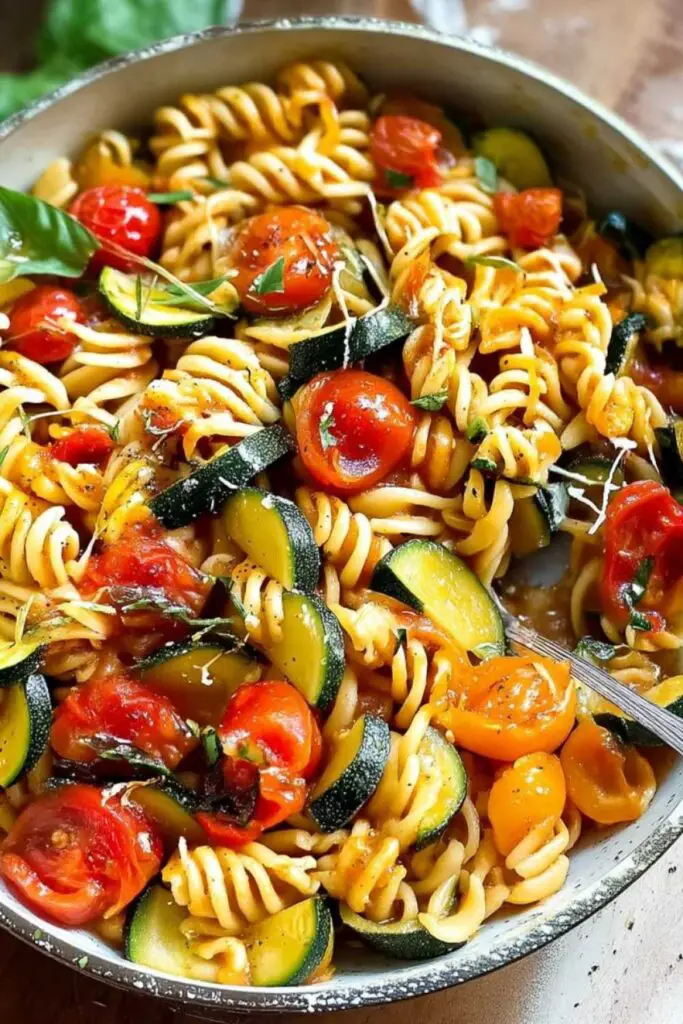
FAQs
How many calories are in tomato zucchini pasta? Each serving contains approximately 850 calories, making it a satisfying but not overly heavy weeknight dinner option that fits well into a balanced diet.
Is tomato zucchini pasta healthy for you? Yes, this dish provides a good balance of vegetables, whole grains, and protein from the parmesan cheese, plus it’s packed with vitamins from the fresh tomatoes and zucchini.
Can I substitute the fusilli pasta with other shapes? Absolutely—I often use penne, rotini, or bow tie pasta depending on what I have in my pantry, and they all work beautifully with the chunky vegetables.
Why does my zucchini get mushy in pasta dishes? To avoid mushy zucchini, cook it over medium-high heat and don’t overcook it—the pieces should be golden on the edges but still have a slight firmness when you bite into them.



